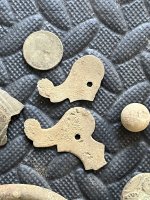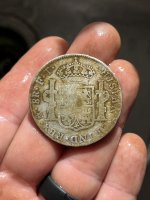You are using an out of date browser. It may not display this or other websites correctly.
You should upgrade or use an alternative browser.
You should upgrade or use an alternative browser.
Dennis Sanford Interview
- Thread starter uniface
- Start date
JUNKYARD DOG
Hero Member
very good read, interesting, thanks. Wes..
Th3rty7
Silver Member
The Solutrean Hypothesis
5 part video series that mostly debunks Sanford. It also brings up fluted paleo points recently found in China and other areas.
uniface
Silver Member
- Thread starter
- #4
Hi Thirty7
Many thanks for the link !!!!!!!!! If the wind always blows in the same direction the trees grow crooked. Don't want any crooked trees on this end, so contrary opinions (to the extent that they have some foundation) are always of interest.
Full disclosure : My problem, going in, is that I'm nearly deaf -- much too hard of hearing to be able to tell that there's a voiceover with the pictures, even with the volume cranked. So I'm necessarily intuiting the argument from what's shown on the screen. If I'm missing something important, your (or anybody's) pointing out what it is will be appreciated.
That said, the first video and the first half of the second (where I checked out) reminds me of the O.J.Simpson trial defense.
First off (and this is almost an aside), if they're using the "Sandia" point as "evidence" of an early single-shouldered biface in the US (as they seem to be), they're hoping they can slide this past people without examination. Tony Baker wrote an exhaustive history of that excavation (posted at his site), compiled from interviews with the people who carried it out. His bottom line, from the convergence of several lines of probability : the "Sandia Point" was (and is) a hoax by an attention seeker. This is not my claim -- it's his conclusion. Anyone wanting to debate it can do so with him.
Overall, their (as they imagine it) "debunking" of Sanford's position -- and this much is crystal clear even without the sound track -- is what's called, in logic (and law) a Strawman Argument. I.e., first twist what he says completely out of shape, then "prove" that your own distortion of it can't be true, and hope that people confuse your distortion of what he said with what he actually did say so that they suppose you've "refuted" him.
This is what they're doing when they harp on the absence of Solturean-like shouldered and stemmed points in Clovis (which they apparently do for several minutes, as if this is significant). The Straw-Man distortion : If Solturean and Clovis were related, then Clovis should have made stemmed and shouldered points. Since they didn't, they're not related. This is outright fraud.
Sanford's linkage of the two is NOT on the basis of identical point styles. It hinges on the (unique in the archaeological record) identity of their lithic technologies. That is, the way that both of them went about turning a block of chert into a finished tool. Procedure. NOT end result in every artifact class. Their divergence in projectile point design is about as significant as the fact that I had brown hair (now white) and my sister has blonde hair. It's no argument against a common source !!
Let's let Sanford (in an interview) speak for himself :
"They had the only upper-Paleolithic biface technology going in Western Europe," Stanford points out. They were the first to heat-treat flint, and the first to use pressure flaking--removing flakes by pressing with a hardwood or antler tool, rather than by striking with another stone. "In northern Spain, their technology produced biface projectile points with concave bases that are basally thinned," he notes, not bothering to say he could just as well be describing Clovis points. The pressure flakes Solutrean knappers removed are so long it's almost a fluting technique--"almost," he's careful to say, but not quite.
The parallels between Solutrean and Clovis flintknapping techniques seem endless. The core technology, "the way they were knocking off big blades and setting up their core platforms," he explains, "is very similar to the Clovis technique, if not identical." They perfected the outre passé--overshot--flaking technique later seen in Clovis, which removes a flake across the entire face of the tool from margin to margin. It's a complicated procedure, he emphasizes, that has to be set up and steps followed precisely in order to detach regular flakes predictably. When you see outre passé flaking in other cultures, you're looking at a knapper's mistake. The Solutreans, though, set up platforms and followed the technique through to the end, exactly as we see in Clovis. "No one else in the world does that," Stanford insists. "There is very little in Clovis--in fact, nothing--that is not found in Solutrean technology," he declares.
Archaeologist Kenneth Tankersley of Kent State University seconds Stanford and Bradley's opinion: "There are only two places in the world and two times that this technology appears--Solutrean and Clovis."
On and on the similarities pile up. We find carved tablets in Clovis sites remarkably similar to Solutrean specimens. Both cultures cached toolstone and finished implements. Stanford and Bradley know of about 20 instances of caches at Solutrean sites; in North America, by comparison, according to Stanford, "we're up to about nine or ten." Just like Clovis knappers, Solutreans used flakes detached by outre passé to make scrapers and knives. Clovis bone projectile points bear an uncanny resemblance to ones made by Solutreans. When French archaeologists saw the cast of a wrench used by Clovis craftsmen at the Murray Springs site in Arizona to straighten spear shafts, they declared it remarkably similar to one found at a Solutrean site.
http://archaeology.about.com/library/we ... 103199.htm
All of the tools and techniques of Clovis can be found in Solutrean assemblages, including thin projectile points, wedges, very long thin bifaces, outré passé flaking, red ochre, gouge-eyed needles, bone and ivory projectiles points, bevelled ivory foreshafts, decorated bone rods, and limestone palettes.
There's more, but I suspect the general drift of it is clear enough by now.
Cheers & Regards
Uni
Many thanks for the link !!!!!!!!! If the wind always blows in the same direction the trees grow crooked. Don't want any crooked trees on this end, so contrary opinions (to the extent that they have some foundation) are always of interest.
Full disclosure : My problem, going in, is that I'm nearly deaf -- much too hard of hearing to be able to tell that there's a voiceover with the pictures, even with the volume cranked. So I'm necessarily intuiting the argument from what's shown on the screen. If I'm missing something important, your (or anybody's) pointing out what it is will be appreciated.
That said, the first video and the first half of the second (where I checked out) reminds me of the O.J.Simpson trial defense.
First off (and this is almost an aside), if they're using the "Sandia" point as "evidence" of an early single-shouldered biface in the US (as they seem to be), they're hoping they can slide this past people without examination. Tony Baker wrote an exhaustive history of that excavation (posted at his site), compiled from interviews with the people who carried it out. His bottom line, from the convergence of several lines of probability : the "Sandia Point" was (and is) a hoax by an attention seeker. This is not my claim -- it's his conclusion. Anyone wanting to debate it can do so with him.
Overall, their (as they imagine it) "debunking" of Sanford's position -- and this much is crystal clear even without the sound track -- is what's called, in logic (and law) a Strawman Argument. I.e., first twist what he says completely out of shape, then "prove" that your own distortion of it can't be true, and hope that people confuse your distortion of what he said with what he actually did say so that they suppose you've "refuted" him.
This is what they're doing when they harp on the absence of Solturean-like shouldered and stemmed points in Clovis (which they apparently do for several minutes, as if this is significant). The Straw-Man distortion : If Solturean and Clovis were related, then Clovis should have made stemmed and shouldered points. Since they didn't, they're not related. This is outright fraud.
Sanford's linkage of the two is NOT on the basis of identical point styles. It hinges on the (unique in the archaeological record) identity of their lithic technologies. That is, the way that both of them went about turning a block of chert into a finished tool. Procedure. NOT end result in every artifact class. Their divergence in projectile point design is about as significant as the fact that I had brown hair (now white) and my sister has blonde hair. It's no argument against a common source !!
Let's let Sanford (in an interview) speak for himself :
"They had the only upper-Paleolithic biface technology going in Western Europe," Stanford points out. They were the first to heat-treat flint, and the first to use pressure flaking--removing flakes by pressing with a hardwood or antler tool, rather than by striking with another stone. "In northern Spain, their technology produced biface projectile points with concave bases that are basally thinned," he notes, not bothering to say he could just as well be describing Clovis points. The pressure flakes Solutrean knappers removed are so long it's almost a fluting technique--"almost," he's careful to say, but not quite.
The parallels between Solutrean and Clovis flintknapping techniques seem endless. The core technology, "the way they were knocking off big blades and setting up their core platforms," he explains, "is very similar to the Clovis technique, if not identical." They perfected the outre passé--overshot--flaking technique later seen in Clovis, which removes a flake across the entire face of the tool from margin to margin. It's a complicated procedure, he emphasizes, that has to be set up and steps followed precisely in order to detach regular flakes predictably. When you see outre passé flaking in other cultures, you're looking at a knapper's mistake. The Solutreans, though, set up platforms and followed the technique through to the end, exactly as we see in Clovis. "No one else in the world does that," Stanford insists. "There is very little in Clovis--in fact, nothing--that is not found in Solutrean technology," he declares.
Archaeologist Kenneth Tankersley of Kent State University seconds Stanford and Bradley's opinion: "There are only two places in the world and two times that this technology appears--Solutrean and Clovis."
On and on the similarities pile up. We find carved tablets in Clovis sites remarkably similar to Solutrean specimens. Both cultures cached toolstone and finished implements. Stanford and Bradley know of about 20 instances of caches at Solutrean sites; in North America, by comparison, according to Stanford, "we're up to about nine or ten." Just like Clovis knappers, Solutreans used flakes detached by outre passé to make scrapers and knives. Clovis bone projectile points bear an uncanny resemblance to ones made by Solutreans. When French archaeologists saw the cast of a wrench used by Clovis craftsmen at the Murray Springs site in Arizona to straighten spear shafts, they declared it remarkably similar to one found at a Solutrean site.
http://archaeology.about.com/library/we ... 103199.htm
All of the tools and techniques of Clovis can be found in Solutrean assemblages, including thin projectile points, wedges, very long thin bifaces, outré passé flaking, red ochre, gouge-eyed needles, bone and ivory projectiles points, bevelled ivory foreshafts, decorated bone rods, and limestone palettes.
There's more, but I suspect the general drift of it is clear enough by now.
Cheers & Regards
Uni
Users who are viewing this thread
Total: 2 (members: 0, guests: 2)







